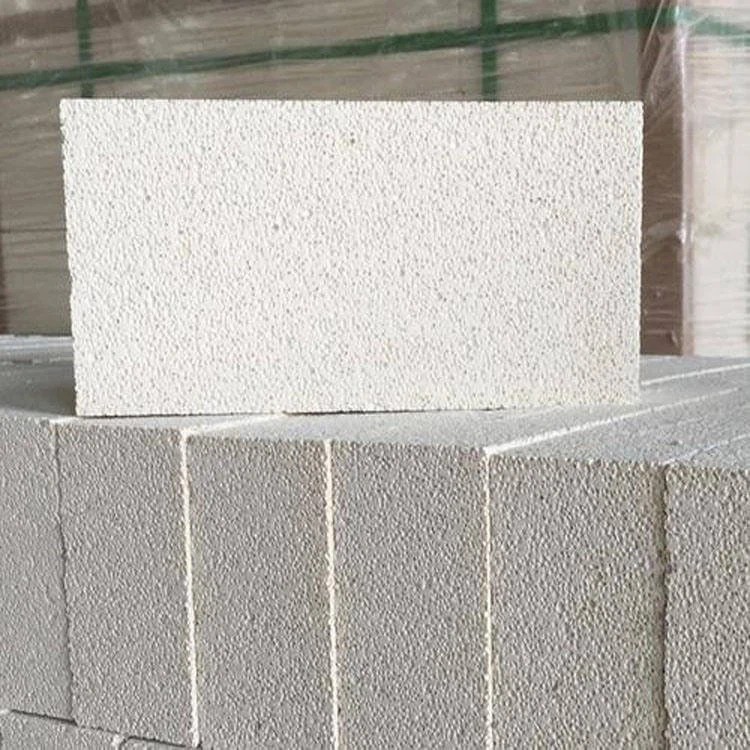PRODUCTS
Insulation Mullite Brick
The bulk density of thermal insulation mullite bricks can be between 0.5 0.6 0.8 0.9 1.0 1.2 1.5 according to user requirements. It acts on the high temperature kiln and directly contacts the flame, with good thermal insulation effect, high compressive strength and low thermal conductivity. The crystallinity of fused mullite is larger than that of sintered mullite, and its thermal shock resistance is better than that of sintered products. Their high temperature performance is mainly determined by the alumina content and the homogeneity of the mullite phase and glass distribution. Features 1. Lo
Composition: Premium materials such as high alumina oxide, magnesium oxide, and silicon carbide, with customizable composition based on client requirements.
Form: Available in powder, brick, board, and castable forms to suit various application needs.
Refractoriness: Standard range from 1200°C to 1800°C, with options for higher temperature customization.
Application Fields: Widely used in industries such as steel, cement, glass, and petrochemicals for furnace lining and insulation.
Packaging: Options include 25 kg bags, bulk bags, and custom packaging solutions compliant with global transportation standards.
Introduction
Our experienced R&D team can customize the material, form, and size according to your specific application needs while ensuring compliance with international quality standards. With rigorous quality control and advanced production facilities, we guarantee products with high refractoriness, excellent compressive strength, and long-lasting durability. Whether you are in the steel, cement, glass, or petrochemical industry, we are your trusted partner, supporting the success of your projects.
For customization inquiries, please feel free to contact us. We will provide tailor-made solutions based on your requirements.
Insulation Mullite Brick Details
The bulk density of thermal insulation mullite bricks can be between 0.5 0.6 0.8 0.9 1.0 1.2 1.5 according to user requirements. It acts on the high temperature kiln and directly contacts the flame, with good thermal insulation effect, high compressive strength and low thermal conductivity. The crystallinity of fused mullite is larger than that of sintered mullite, and its thermal shock resistance is better than that of sintered products. Their high temperature performance is mainly determined by the alumina content and the homogeneity of the mullite phase and glass distribution.
Features
1. Low thermal melting, due to low thermal conductivity, mullite series lightweight insulating bricks accumulate little heat energy, and the energy saving effect is obvious in intermittent operation;
2. Low thermal conductivity, with good thermal insulation effect;
3. Low impurity content has very low oxide content such as alkali metal in iron box, therefore, high refractoriness;
4. High thermal compressive strength;
5. It can be processed into special shapes to reduce the number of bricks and joints;
6. The appearance size is accurate, the speed of masonry is accelerated, the usage of refractory mud is reduced, and the strength and stability of the masonry are guaranteed, thereby prolonging the life of the lining.
Applications
Mainly used in metallurgical hot blast stoves with high air temperature above 1400℃, parts of torpedo vehicles impacted by molten iron, slag lines, furnace roofs of steelmaking electric arc furnaces, forehearths of glass melting furnaces, regenerator arches, superstructures, ceramic sintering kilns, Ceramic roller kiln, tunnel kiln, electric porcelain drawer kiln, dead angle furnace lining of petroleum cracking system, glass crucible kiln and lining of various electric furnaces, etc. The wall of the clarifier can directly contact the flame.
Physical And Chemical Indicators
|
Item |
Performance |
||||
|
JM-23 |
JM-24 |
JM-26 |
JM-28 |
JM-30 |
|
|
Classification temperature(℃) |
1260 |
1350 |
1430 |
1540 |
1650 |
|
Bulk density g/cm3 |
0.6 |
0.8 |
0.8-1.0 |
0.9-1.1 |
1.0-1.2 |
|
Compressive strength Mpa |
1.3 |
2.0 |
3.0 |
3.5 |
3.5 |
|
Reburn line changes %(℃xh) |
1250×12 -0.5 |
1320×12 -0.5 |
1400×12 -0.5 |
1510×12 -0.9 |
1600×12 -0.9 |
|
Thermal Conductivity W/m.k(350±25℃) |
0.22 |
0.26 |
0.26 |
0.32 |
0.41 |
|
AL2O3 |
50 |
55 |
60 |
65 |
70 |
|
Fe2O3 |
1.2 |
1.2 |
1.2 |
1.0 |
1.0 |













